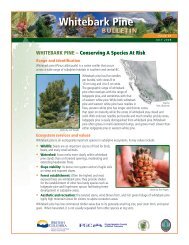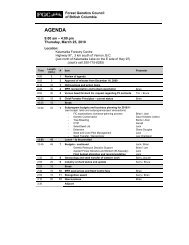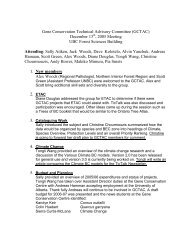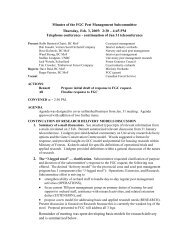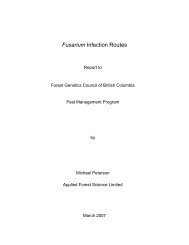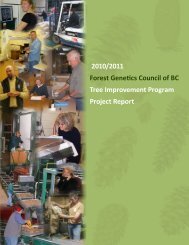Tree Improvement Program Project Report 2006 / 2007
Tree Improvement Program Project Report 2006 / 2007
Tree Improvement Program Project Report 2006 / 2007
You also want an ePaper? Increase the reach of your titles
YUMPU automatically turns print PDFs into web optimized ePapers that Google loves.
The provincial status report on interior broadleaf species<br />
is in preparation and should be completed by the end of<br />
<strong>2007</strong>.<br />
Red alder<br />
A clone bank for the southern breeding zone has been<br />
established at the Cowichan Lake Research Station with 87<br />
clones selected from the provenance-progeny trial at Bowser<br />
on Vancouver Island. Fifty-seven clones have also been<br />
selected from the provenance-progeny trial at Thunderbird<br />
near Terrace. As at the Bowser site, selection was based<br />
on the breeding value of the stem volume and other<br />
characteristics such as stem form, branch size and angle, etc.<br />
To control the relatedness of the clones, the bank includes<br />
no more than three individuals from each family.<br />
Black Cottonwood<br />
The third long-term provenance-clonal trial was established<br />
at Harrison Mills in the spring of <strong>2007</strong> with 3270 trees of<br />
516 clones from 142 provenances. The first measurements<br />
(age 2) have been taken for the Terrace and Red Rock trials<br />
planted in 2005. Significant vole damage at the Terrace<br />
site and frost damage at the Red Rock site were observed<br />
and will be surveyed this fall during the second round of<br />
measurements.<br />
B g-leaf Maple<br />
One–year-old seedlings in styroblocks 615 have been<br />
transplanted into styroblocks 723 for another growing<br />
season. Seedlings will be lifted this winter and planted out<br />
next spring. The total height of a seedling, including its<br />
root, will not exceed 36 inches. Four sites — Sayward on<br />
northern Vancouver Island, Skutz Falls on the south island,<br />
Powell River on the north coast, and Seabird Island in the<br />
southern mainland — have been selected for the long-term<br />
provenance-progeny testing program. The Sayward, Skutz<br />
Falls, and Powell River sites have been fenced and herbicide<br />
treatment will be applied later this summer.<br />
T R E E I M P R O V E M E N T P R O G R A M<br />
P R O J E C T R E P O R T 2 0 0 6 / 2 0 0 7<br />
.9 Inter or Douglas-fir <strong>Tree</strong><br />
Breed ng <strong>Program</strong><br />
Barry Jaqu sh, Val Ashley, G sele Ph ll ps and<br />
Bonn e Hooge<br />
The BC Interior Douglas-fir tree-breeding program began<br />
in 1982 and is based on phenotypic selection in wild<br />
stands, open-pollinated (o.p.) progeny testing, clonal seed<br />
orchards established through backward selection on the<br />
original parents, and controlled mating to produce pedigree<br />
material for second-generation selection. <strong>Tree</strong> height,<br />
diameter, and volume are the major traits considered for<br />
improvement. The first generation of breeding includes<br />
1,466 open-pollinated families in six seed planning units<br />
(SPU). Seed orchards were established in the early-mid<br />
1990s and are now coming into production.<br />
In <strong>2006</strong>, the flower crop was sparse, and only 67<br />
crosses were completed in all six SPUs. One hundred and<br />
sixty-five pollen lots were collected, extracted, and stored<br />
for future breeding. Controlled crossing for the highest<br />
priority Nelson SPUs is now about 75 percent complete.<br />
Four 15-year-old progeny tests in the East Kootenay SPU<br />
were maintained and measured. Breeding values (BV)<br />
for rotation-age volume were estimated by Best Linear<br />
Prediction (BLP) and ranged from -87.6 to 37.2 percent.<br />
The BV for the top 30 East Kootenay parents averaged 25.2<br />
percent. In the Nelson low-elevation SPU, four 20-year-old<br />
sites were maintained and two were measured.<br />
Data analyses for this zone are in progress. Several<br />
research plantings were maintained and measured,<br />
including the 20-year-old seedling/steckling study and five<br />
Submaritime Douglas-fir adaptation tests.<br />
The pilot Interior Douglas-fir Armillaria genetic<br />
resistance study was completed. This test included 1,566<br />
trees from 88 o.p. families and four SPUs. The artificial<br />
inoculation technique proved very effective because<br />
Armillaria was present in 1,408 of the 1,566 treated trees<br />
(Figure 9). After three years, 83 percent of the trees had<br />
been killed by Armillaria and six percent of the living trees<br />
were completely girdled and near death. Family mortality<br />
ranged from 44 to 100 percent. In general, families from<br />
warmer and drier environments were less susceptible to<br />
mortality than trees from colder and wetter environments.<br />
Analyses of the 30-year-old range-wide Interior<br />
Douglas-fir provenance test at Trinity Valley showed that<br />
provenances from the east slopes of the Coast and Cascade<br />
13



